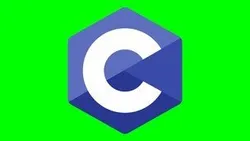
C Programming: Getting Started - 1 
This course provides an introduction to the C programming language, allowing learners to quickly get up and running with coding. Through hands-on exercises, participants will gain the skills needed to write and debug C programs. ▼
ADVERTISEMENT
Course Feature
![]() Cost:
Cost:
Free
![]() Provider:
Provider:
Coursera
![]() Certificate:
Certificate:
Paid Certification
![]() Language:
Language:
English
![]() Start Date:
Start Date:
29th May, 2023
Course Overview
❗The content presented here is sourced directly from Coursera platform. For comprehensive course details, including enrollment information, simply click on the 'Go to class' link on our website.
Updated in [March 06th, 2023]
Learners can learn a variety of topics from this course, including:
1. The fundamentals of the C programming language, such as writing your first programs, making simple computations, printing results to the screen, storing values in variables, and repeating instructions using loops.
2. How C is used in a variety of applications, such as powering smartphones, car navigation systems, robots, drones, trains, and other electronic devices.
3. The importance of C in the world of computer information technology, and how it is a foundational programming language taught at engineering schools around the world.
4. How to use powerful yet simple coding tools right within the web browser, without the need to install anything.
[Applications]
Upon completion of this course, learners will have a foundational understanding of the C programming language and be able to apply it to their own projects. Learners will be able to use powerful yet simple coding tools right within the web browser to write their own C programs. They will also have the knowledge to continue their journey in the C Programming with Linux Specialization and become skilled C programmers.
[Career Paths]
Recommended career paths for learners of this course include:
1. Software Developer: Software developers create and maintain software applications and systems. They use C programming language to develop software applications and systems that are used in a variety of industries. Software developers must have a strong understanding of computer science and programming principles, and be able to work with a variety of programming languages. The demand for software developers is growing rapidly, and the job outlook is expected to remain strong in the coming years.
2. Embedded Systems Engineer: Embedded systems engineers design and develop embedded systems, which are computer systems that are embedded into larger systems. They use C programming language to develop embedded systems for a variety of industries, such as automotive, aerospace, and medical. Embedded systems engineers must have a strong understanding of computer science and programming principles, and be able to work with a variety of programming languages. The demand for embedded systems engineers is growing rapidly, and the job outlook is expected to remain strong in the coming years.
3. Robotics Engineer: Robotics engineers design and develop robots for a variety of industries, such as manufacturing, healthcare, and defense. They use C programming language to develop robots that are used in a variety of applications. Robotics engineers must have a strong understanding of computer science and programming principles, and be able to work with a variety of programming languages. The demand for robotics engineers is growing rapidly, and the job outlook is expected to remain strong in the coming years.
4. Computer Network Engineer: Computer network engineers design and develop computer networks for a variety of industries, such as telecommunications, healthcare, and finance. They use C programming language to develop computer networks that are used in a variety of applications. Computer network engineers must have a strong understanding of computer science and programming principles, and be able to work with a variety of programming languages. The demand for computer network engineers is growing rapidly, and the job outlook is expected to remain strong in the coming years.
[Education Paths]
Recommended Degree Paths:
1. Bachelor of Science in Computer Science: This degree program provides students with a comprehensive understanding of computer science fundamentals, including programming, software engineering, and computer architecture. Students will learn the latest technologies and develop the skills needed to design, develop, and maintain software applications. This degree is ideal for those looking to pursue a career in software engineering, computer programming, or computer systems engineering.
2. Master of Science in Computer Science: This degree program provides students with an advanced understanding of computer science fundamentals, including programming, software engineering, and computer architecture. Students will learn the latest technologies and develop the skills needed to design, develop, and maintain software applications. This degree is ideal for those looking to pursue a career in software engineering, computer programming, or computer systems engineering.
3. Bachelor of Science in Information Technology: This degree program provides students with a comprehensive understanding of information technology fundamentals, including programming, software engineering, and computer architecture. Students will learn the latest technologies and develop the skills needed to design, develop, and maintain software applications. This degree is ideal for those looking to pursue a career in software engineering, computer programming, or computer systems engineering.
4. Master of Science in Information Technology: This degree program provides students with an advanced understanding of information technology fundamentals, including programming, software engineering, and computer architecture. Students will learn the latest technologies and develop the skills needed to design, develop, and maintain software applications. This degree is ideal for those looking to pursue a career in software engineering, computer programming, or computer systems engineering.
Developing Trends:
1. Artificial Intelligence: Artificial intelligence (AI) is becoming increasingly important in the field of computer science. AI is used to create intelligent systems that can learn, reason, and act autonomously. AI is being used to develop autonomous vehicles, intelligent robots, and other applications.
2. Cloud Computing: Cloud computing is becoming increasingly important in the field of computer science. Cloud computing is used to store and access data and applications over the internet. It is being used to develop applications that can be accessed from anywhere in the world.
3. Internet of Things: The Internet of Things (IoT) is becoming increasingly important in the field of computer science. IoT is used to connect physical devices to the internet, allowing them to communicate with each other and with other devices. It is being used to develop applications that can be used to monitor and control physical devices.
4. Cybersecurity: Cybersecurity is becoming increasingly important in the field of computer science. Cybersecurity is used to protect data and systems from malicious attacks. It is being used to develop applications that can detect and prevent cyber attacks.
Pros & Cons

Clear explanations by professors.

Powerful codecast tool.

Detailed instruction and hands on activities.

Simple and practical teaching method.

Auditing seems impossible.

Payment only content.

Limited access to free courses.

No deeper exploration of C and Linux.
Course Provider

Provider Coursera's Stats at AZClass
Discussion and Reviews
0.0 (Based on 0 reviews)
Explore Similar Online Courses

Fundamentals of Music Theory

Productivity Machine: Time Management & Productivity Hacks

Python for Informatics: Exploring Information

Social Network Analysis

Introduction to Systematic Review and Meta-Analysis

The Analytics Edge

DCO042 - Python For Informatics

Causal Diagrams: Draw Your Assumptions Before Your Conclusions

Whole genome sequencing of bacterial genomes - tools and applications

Learn C Programming Using the Classic Book by Kernighan and Ritchie

C Programming: Modular Programming and Memory Management - 3

C - Fast Crash Course - Introduction
 Related Categories
Related Categories
Quiz
 Submitted Sucessfully
Submitted Sucessfully
1. What is C programming used for?
2. What is the first course in the C Programming with Linux Specialization?
3. What is the purpose of this course?


Start your review of C Programming: Getting Started - 1